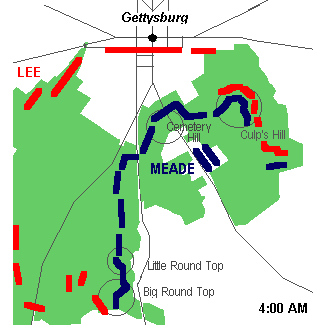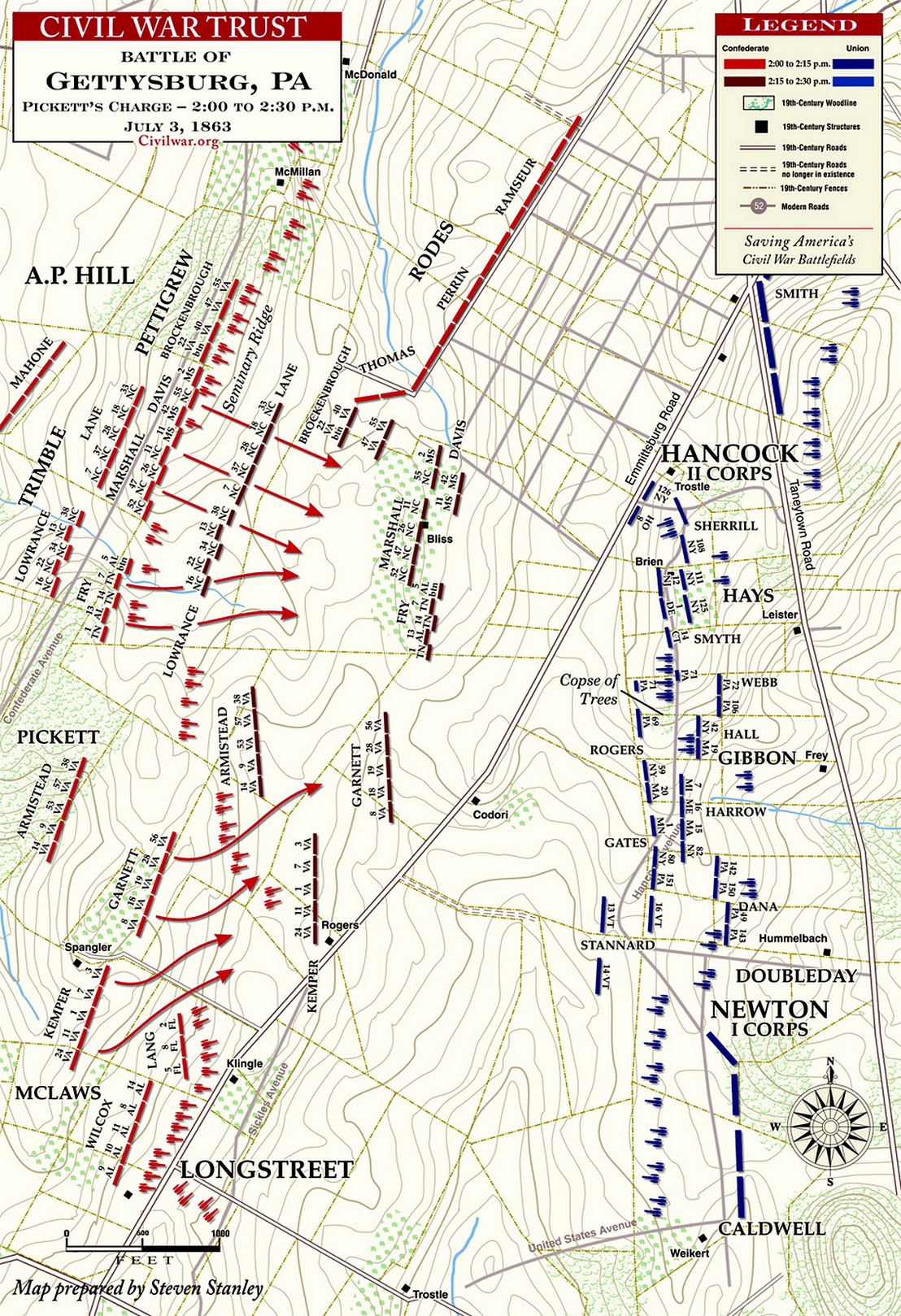|
| Map of Pickett's Charge on July 3,1863 |

|
| Map of troop movements during Pickett's Charge |
In the numerous accounts of the Battle of Gettysburg heretofore published, the writers have generally referred to the last effort made by the Confederate troops as "Pickett's Charge," and in almost every instance have conveyed the idea that no troops but Pickett's division took an active part in that fierce
and tremendous struggle. Disclaiming any intention to detract in the least from the glory won on that day by the gallant Virginia
division, or its heroic commander, who had then been for more than twenty years one of my most valued friends, I may be permitted
to say that some injustice has been done to the division commanded by General Pettigrew.
As colonel of the Thirteenth Alabama infantry, I was attached to Archer's brigade of Heth's division. That
brigade opened the battle on the morning of July 1st, and during the fighting which immediately ensued General
Heth was wounded, and the command of the division devolved upon Brigadier-General Pettigrew. General Archer was captured,
and I succeeded him in command of the brigade.
During the forenoon of the 3d, while our division was resting in line behind the ridge and skirt of woods
which masked us from the enemy, Generals Lee, Longstreet and A. P. Hill rode up, and, dismounting, seated themselves on the trunk of a fallen tree some fifty or sixty
paces from where I sat on my horse at the right of our division. After an apparently careful examination of a map, and a consultation
of some length, they remounted and rode away. Staff officers and couriers began to move briskly about, and a few minutes after
General Pettigrew rode up and informed me that after a heavy cannonade we would assault the position in our front, and added:
"They will of course return the fire with all the guns they have; we must shelter the men as best we can, and make them lie
down." At the same time he directed me to see General Pickett at once and have an understanding as to the dress in
the advance. I rode to General Pickett, whose division was formed on the right of and in line with ours. He appeared to be
in excellent spirits, and, after a cordial greeting and a pleasant reference to our having been together in work of that kind
at Chapultepec, expressed great confidence in the ability of our troops to drive the enemy after they had been "demoralized
by our artillery." General Garnett, who commanded his left brigade, having joined us, it was agreed that he would dress on
my command. I immediately returned and informed General Pettigrew of this agreement. It was then understood that my command
should be considered the centre, and that in the assault both divisions should align themselves by it. Soon after the two
divisions moved forward about a hundred paces, and the men lay down behind our line of batteries. The cannonade which followed
has been often and justly described as the most terrible of the war. In it my command suffered a considerable loss. Several
officers were killed and wounded, with a number of the rank and file. I received a painful wound on the right shoulder from
a fragment of shell. After lying inactive under that deadly storm of hissing and exploding missiles, it seemed a relief to
go forward to the desperate assault. At a signal from Pettigrew I called my command to attention. The men sprang up with cheerful
alacrity, and the long line advanced. "Stormed at with shot and shell," it moved steadily on, and even when grape, canister,
and musket balls began to rain upon it the gaps were quickly closed and the alignment preserved. Strong as was the position
of the enemy, it seemed that such determination could not fail. I heard Garnett give a command to his men which, amid the
rattle of musketry, I could not distinguish. Seeing my look or gesture of inquiry, he called our, "I am dressing on you!"
A few seconds after, he fell dead. A moment later- and after Captain Williams and Colonel George had been wounded by my side-
a shot through the thigh prostrated me. I was so confident of victory that to some of my men who ran up to carry me off I
shouted, "Go on; it will not last five minutes longer!" The men rushed forward into the smoke, which soon became so dense
that I could see little of what was going on before me. But a moment later I heard General Pettigrew, behind me, calling to
some of his staff to "rally them on the left." The roll of musketry was then incessant, and I believe that the Federal troops-
probably blinded by the smoke- continued a rapid fire for some minutes after none but dead and wounded remained in their front.
At length the firing ceased, and cheer after cheer from the enemy announced the failure of our attack. I was of course left
a prisoner.
| Pickett's Charge Gettysburg Map |

|
| Pickett's Charge Battlefield Map |
As evidence of how close was the fighting at that part of the line, I saw a Federal soldier with an ugly wound
in his shoulder, which he told me he received from the spear on the end of one of my regimental colors; and I remembered having
that morning observed and laughingly commented on the fact that the color-bearer of the Thirteenth Alabama had attached to
his staff a formidable-looking lance head. All of the five regimental colors of my command reached the line of the enemy's
works, and many of my men and officers were killed or wounded after passing over it. I believe the same was true of other
brigades in General Pettigrew's command.
It is probable that Pickett's division, which up to that time had taken no part in the battle, was mainly
relied upon for the final assault; but whatever may have been the first plan of attack, the division under Pettigrew went
into it as part of the line of battle, and from the commencement of the advance to the closing death grapple, his right brigade
was the directing one. General Pettigrew, who I know was that day in the thickest of the fire, was killed in a skirmish a
few days later. No more earnest and gallant officer served in the Confederate army.
B. D. Fry.
Montgomery, Alabama, December 14th, 1878.
(Source: Southern Historical Society Papers, Vol. 7, pp. 91-93)
Recommended Reading: Pickett's Charge,
by George Stewart. Description: The author has written
an eminently readable, thoroughly enjoyable, and well-researched book on the third day of the Gettysburg battle, July 3, 1863. An especially rewarding read if one has toured, or plans
to visit, the battlefield site. The author's unpretentious, conversational style of writing succeeds in putting the reader
on the ground occupied by both the Confederate and Union forces before, during and after
Pickett's and Pettigrew's famous assault on Meade's Second Corps. Continued below...
Interspersed
with humor and down-to-earth observations concerning battlefield conditions, the author conscientiously describes all aspects
of the battle, from massing of the assault columns and pre-assault artillery barrage to the last shots and the flight of the
surviving rebels back to the safety of their lines… Having visited Gettysburg several years ago, this superb volume makes me
want to go again.
Recommended
Reading: Pickett's Charge--The Last Attack at Gettysburg (Hardcover). Description: Pickett's Charge is probably the best-known military engagement of the Civil War,
widely regarded as the defining moment of the battle of Gettysburg
and celebrated as the high-water mark of the Confederacy. But as Earl Hess notes, the epic stature of Pickett's Charge has
grown at the expense of reality, and the facts of the attack have been obscured or distorted by the legend that surrounds
them. With this book, Hess sweeps away the accumulated myths about Pickett's Charge to provide the definitive history of the
engagement. Continued below...
Drawing on
exhaustive research, especially in unpublished personal accounts, he creates a moving narrative of the attack from both Union and Confederate perspectives,
analyzing its planning, execution, aftermath, and legacy. He also examines the history of the units involved, their state
of readiness, how they maneuvered under fire, and what the men who marched in the ranks thought about their participation
in the assault. Ultimately, Hess explains, such an approach reveals Pickett's Charge both as a case study in how soldiers
deal with combat and as a dramatic example of heroism, failure, and fate on the battlefield.
Recommended Reading: Into the Fight: Pickett's Charge
at Gettysburg. Description: Challenging conventional views, stretching the minds of Civil War enthusiasts and
scholars as only John Michael Priest can, Into the Fight is both a scholarly and a revisionist interpretation of the most
famous charge in American history. Using a wide array of sources, ranging from the monuments on the Gettysburg battlefield to the accounts of the participants themselves, Priest rewrites the
conventional thinking about this unusually emotional, yet serious, moment in our Civil War. Continued below...
Starting with
a fresh point of view, and with no axes to grind, Into the Fight challenges all interested in that stunning moment in history
to rethink their assumptions. Worthwhile for its use of soldiers’ accounts, valuable for its forcing the reader to rethink
the common assumptions about the charge, critics may disagree with this research, but they cannot ignore it.
Recommended Reading: Pickett's
Charge in History and Memory. Description:
Pickett's Charge--the Confederates' desperate (and failed) attempt to break the Union lines on the third and final day of
the Battle of Gettysburg--is best remembered as the turning point of the U.S. Civil War. But Penn State historian Carol Reardon reveals
how hard it is to remember the past accurately, especially when an event such as this one so quickly slipped into myth. She
writes, "From the time the battle smoke cleared, Pickett's Charge took on this chameleon-like aspect and, through a variety
of carefully constructed nuances, adjusted superbly to satisfy the changing needs of Northerners, Southerners, and, finally,
the entire nation." Continued below...
With
care and detail, Reardon's fascinating book teaches a lesson in the uses and misuses of history.
Recommended Reading: Pickett's Charge: Eyewitness Accounts At The Battle
Of Gettysburg (Stackpole Military History Series). Description: On the final day of the battle of Gettysburg, Robert E. Lee ordered one of the most famous infantry assaults of all time: Pickett's
Charge. Following a thundering artillery barrage, thousands of Confederates launched a daring frontal attack on the Union
line. From their entrenched positions, Federal soldiers decimated the charging Rebels, leaving the field littered with the
fallen and several Southern divisions in tatters. Written by generals, officers, and enlisted men on both sides, these firsthand
accounts offer an up-close look at Civil War combat and a panoramic view of the carnage of July 3, 1863.
|

